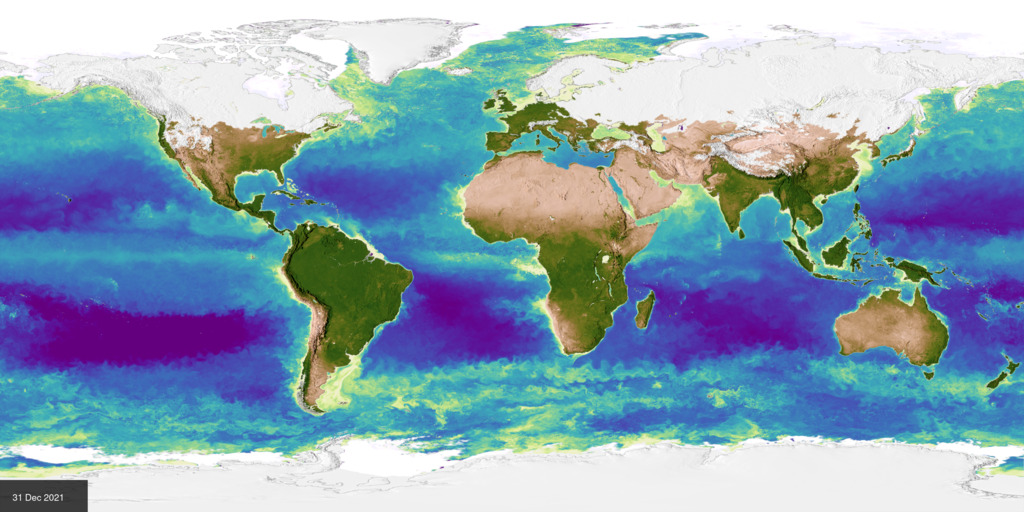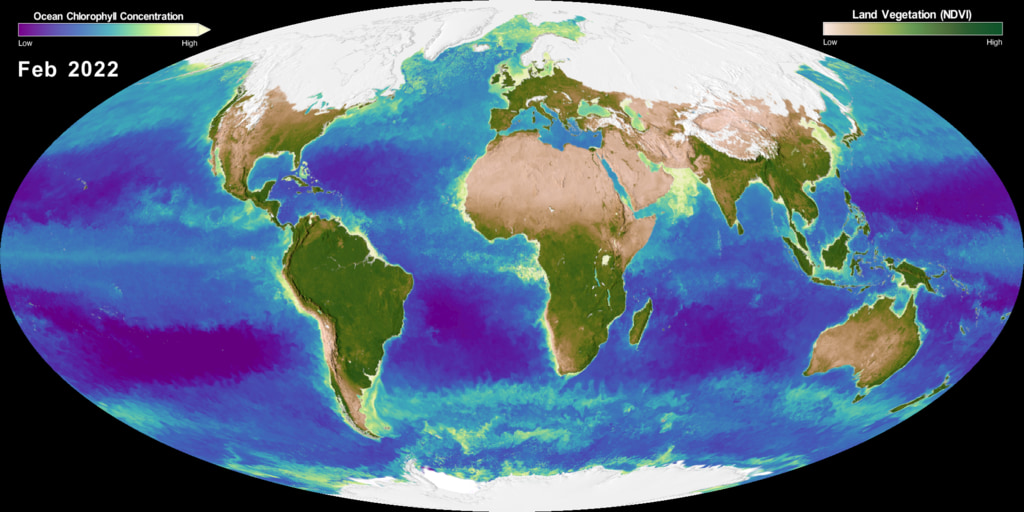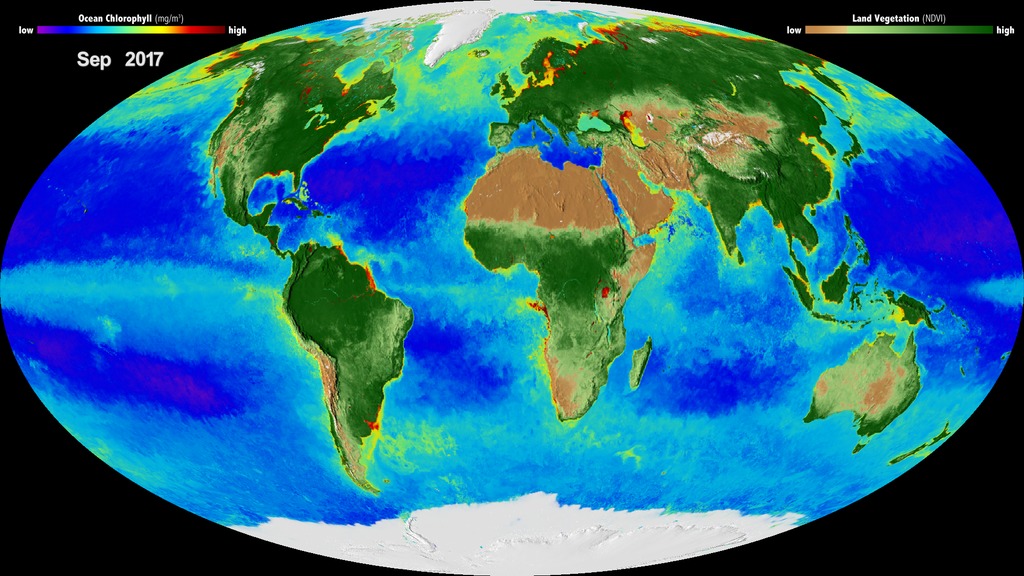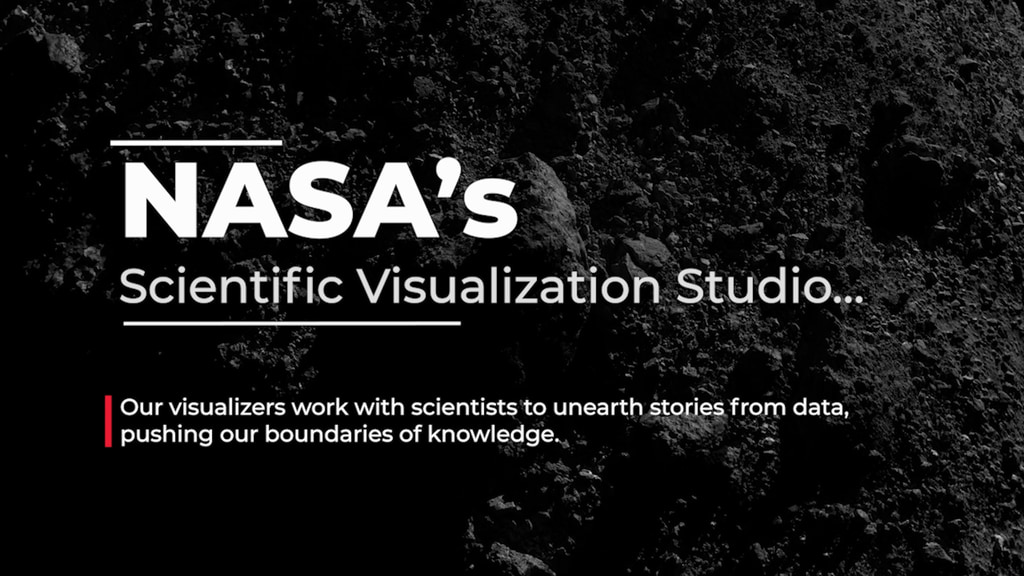A newer version of this visualization is available.
Earth Day 2020: Biosphere
Global Biosphere data from 1997 through 2017 with corresponding colorbars and date stamp.
This video is also available on our YouTube channel.
By monitoring the color of reflected light via satellite, scientists can determine how successfully plant life is photosynthesizing. A measurement of photosynthesis is essentially a measurement of successful growth, and growth means successful use of ambient carbon. This data visualization represents twenty years' worth of data taken primarily by SeaStar/SeaWiFS, Aqua/MODIS, and Suomi NPP/VIIRS satellite sensors, showing the abundance of life both on land and in the sea. In the ocean, dark blue to violet represents warmer areas where there is little life due to lack of nutrients, and greens and reds represent cooler nutrient-rich areas. The nutrient-rich areas include coastal regions where cold water rises from the sea floor bringing nutrients along and areas at the mouths of rivers where the rivers have brought nutrients into the ocean from the land. On land, green represents areas of abundant plant life, such as forests and grasslands, while tan and white represent areas where plant life is sparse or non-existent, such as the deserts in Africa and the Middle East and snow-cover and ice at the poles.
Rotating globe showing the Earth's biosphere over a 20 year period.
Date overlay.

Normalized Difference Vegetation Index (NDVI) colorbar. More commonly known as Land Vegetation.

Ocean Chlorophyll colorbar.
- Biological oceanography
- Biosphere
- Cryology
- Cryosphere
- Earth Science
- Ecological Dynamics
- Ecology
- For Educators
- HDTV
- Hydrosphere
- Hyperwall
- Microbiota Taxonomy
- ocean color
- Ocean Optics
- Oceans
- photosynthesis
- Physical oceanography
- Phytoplankton
- Plant Growth
- Presentation
- Producer
- Sea Ice
- Sea Ice Concentration
- SeaWiFS
- Snow Cover
- Snow/Ice
- Terrestrial Hydrosphere
Credits
Please give credit for this item to:
NASA/Goddard Space Flight Center, The SeaWiFS Project and GeoEye, Scientific Visualization Studio. NOTE: All SeaWiFS images and data presented on this web site are for research and educational use only. All commercial use of SeaWiFS data must be coordinated with GeoEye (NOTE: In January 2013, DigitalGlobe and GeoEye combined to become DigitalGlobe).
-
Data visualizers
- Alex Kekesi (Global Science and Technology, Inc.)
- Horace Mitchell (NASA/GSFC)
- Greg Shirah (NASA/GSFC)
- Cindy Starr (Global Science and Technology, Inc.)
-
Scientists
- Gene Feldman (NASA/GSFC)
- Compton Tucker (NASA/GSFC)
-
Producers
- LK Ward (USRA)
- Patrick Lynch (NASA/GSFC)
-
Data providers
- Norman Kuring (NASA/GSFC)
- George Riggs (SSAI)
Release date
This page was originally published on Tuesday, April 21, 2020.
This page was last updated on Sunday, February 2, 2025 at 12:15 AM EST.
Series
This page can be found in the following series:Datasets used
-
Chlorophyll Concentration [SeaStar: SeaWiFS]
ID: 469All SeaWiFS images and data presented on this web site are for research and educational use only. All commercial use of SeaWiFS data must be coordinated with GeoEye.
Credit: NASA/Goddard Space Flight Center, The SeaWiFS Project and GeoEye, Scientific Visualization Studio. NOTE: All SeaWiFS images and data presented on this web site are for research and educational use only. All commercial use of SeaWiFS data must be coordinated with GeoEye (NOTE: In January 2013, DigitalGlobe and GeoEye combined to become one DigitalGlobe.).
This dataset can be found at: http://oceancolor.gsfc.nasa.gov/PRODUCTS/
See all pages that use this dataset -
Comiso's Daily Sea Ice Concentration
ID: 539 -
NDVI [SeaStar: SeaWiFS]
ID: 601All SeaWiFS images and data presented on this web site are for research and educational use only. All commercial use of SeaWiFS data must be coordinated with GeoEye.
Credit: NASA/Goddard Space Flight Center, The SeaWiFS Project and GeoEye, Scientific Visualization Studio. NOTE: All SeaWiFS images and data presented on this web site are for research and educational use only. All commercial use of SeaWiFS data must be coordinated with GeoEye (NOTE: In January 2013, DigitalGlobe and GeoEye combined to become one DigitalGlobe.).
See all pages that use this dataset -
NDVI [Aqua: MODIS]
ID: 739 -
IMS Daily Northern Hemisphere Snow and Ice Analysis (IMS Daily Northern Hemisphere Snow and Ice Analysis - 24 km Resolution) [Interactive Multisensor Snow and Ice Mapping System (IMS)]
ID: 778This dataset can be found at: http://nsidc.org/data/docs/noaa/g02156_ims_snow_ice_analysis/
See all pages that use this dataset -
chlor_a (Chlorophyll Concentration OCl) [Aqua: MODIS]
ID: 935Credit: Ocean Biology Processing Group (OBPG)
This dataset can be found at: http://oceancolor.gsfc.nasa.gov/cms/atbd/chlor_a
See all pages that use this dataset -
Chlorophyll (Chlorophyll Concentration) [Suomi NPP: VIIRS]
ID: 987 -
Normalized Difference Vegetation Index (NDVI) [Suomi NPP: VIIRS]
ID: 988
Note: While we identify the data sets used on this page, we do not store any further details, nor the data sets themselves on our site.




![Music: Futurity by Lee Groves [PRS] and Peter George Marett [PRS]Complete transcript available.](/vis/a010000/a013900/a013979/Screen_Shot_2021-10-28_at_2.29.18_PM.png)

![Music: A Curious Incident by Jay Price [PRS] and Paul Reeves [PRS]Complete transcript available.](/vis/a010000/a013700/a013781/CO20.jpg)
